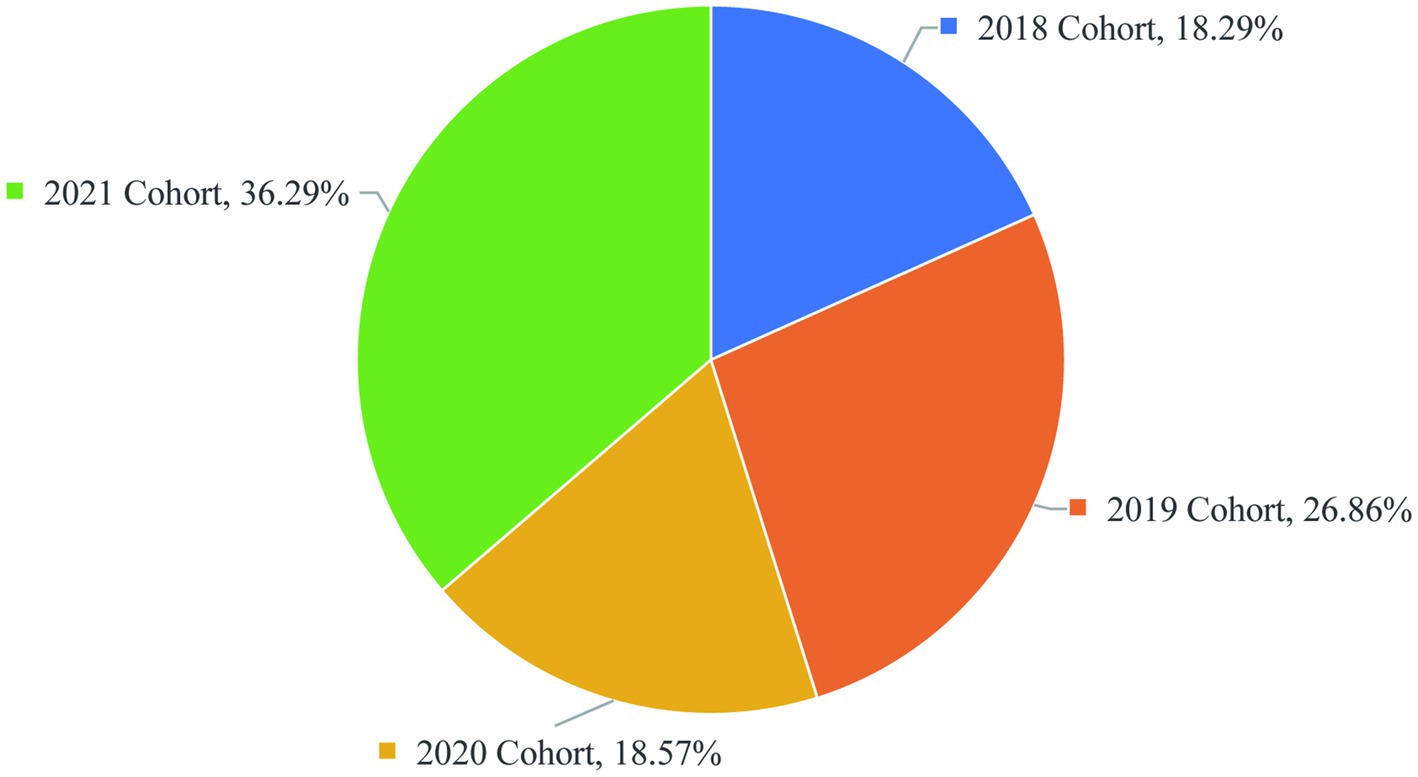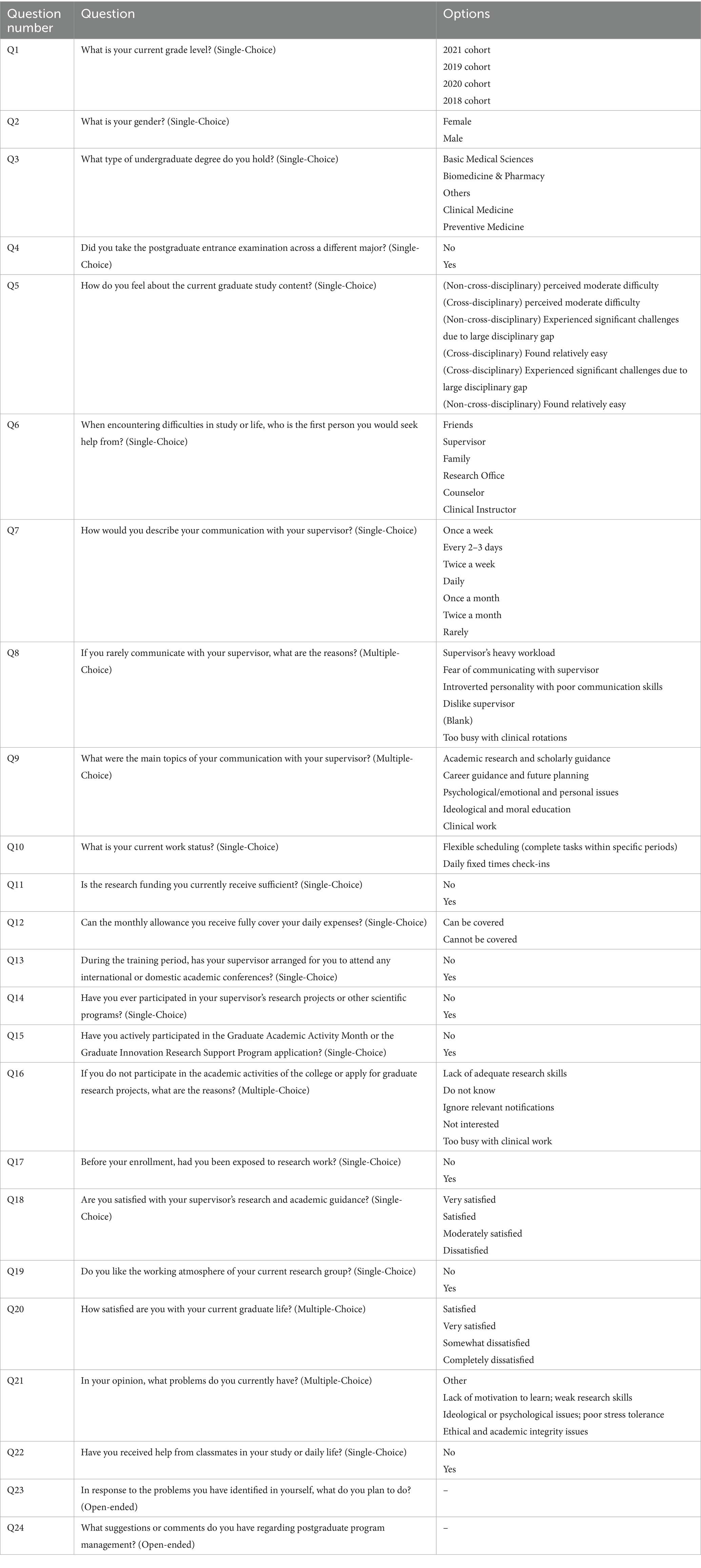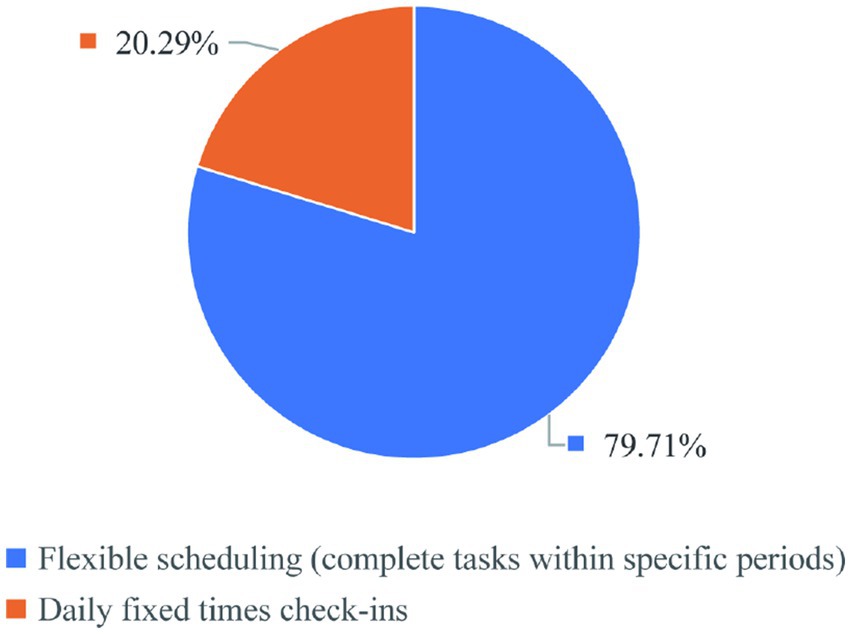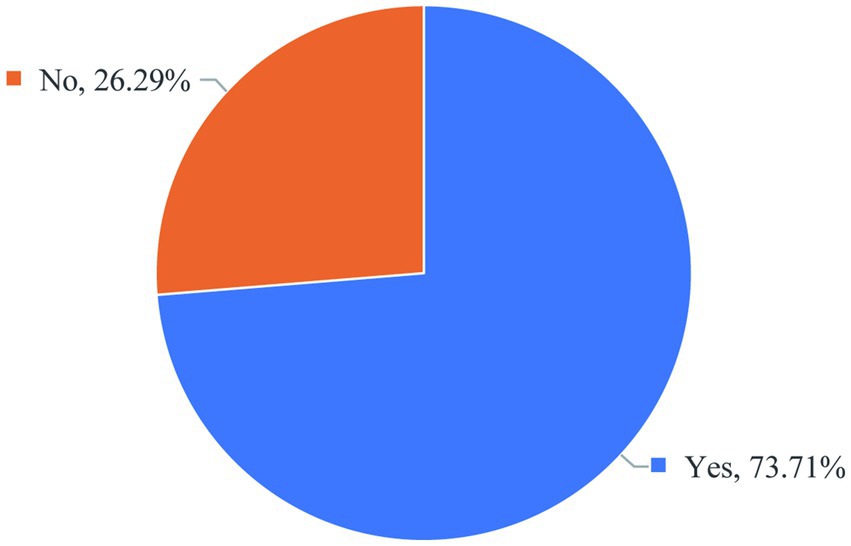- 1Department of Pathology, Xiangya School of Basic Medical Sciences, Central South University, Changsha, China
- 2Department of Pathology, Xiangya Hospital, Central South University, Changsha, China
- 3Medical Research Center, Sun Yat-Sen Memorial Hospital, Sun Yat-Sen University, Guangzhou, China
- 4Guangdong Provincial Key Laboratory of Malignant Tumor Epigenetics and Gene Regulation, Guangdong-Hong Kong Joint Laboratory for RNA Medicine, Sun Yat-Sen Memorial Hospital, Sun Yat-Sen University, Guangzhou, China
- 5Department of Pathology, Ultrapathology (Biomedical Electron Microscopy) Center, Xiangya Hospital, Central South University, Changsha, China
- 6FuRong Laboratory, Changsha, China
- 7National Clinical Research Center for Geriatric Disorders, Xiangya Hospital, Central South University, Changsha, China
Introduction: Under the background of “basic top-notch 2.0” plan, taking the graduate students of Xiangya School of Basic Medical Sciences, Central South University as an example, to explore their current situations in life, academics, scientific research, and team collaboration, thereby offering insights for enhancing the quality of basic medical graduate education in China, achieving the plan’s objectives, and shaping relevant policies.
Methods: An online anonymous questionnaire was sent to graduate students of basic medicine majors in different grades of Xiangya School of Basic Medical Sciences, Central South University. The questionnaire included 24 questions covering different aspects of graduate life, and the data of 350 valid questionnaires were analyzed. The study reveals diverse academic backgrounds among basic medical graduate students, with nearly half (50%) originating from different disciplines.
Results: Over 14% of students reported encountering learning difficulties, and many tended to seek help from peers rather than supervisors due to limited communication with their advisors. Approximately 80% of graduate students had flexible time management, yet only 26% received sufficient stipends to cover daily expenses, with an equal proportion facing inadequate research funding. Academic engagement was moderate (54.7%), though some students demonstrated low participation enthusiasm. Notably, nearly one-third (33.3%) had no prior research experience before enrollment. While overall satisfaction with supervisors’ academic and research guidance was high (96.29%), senior students exhibited a slight decline in satisfaction. A strong preference for the teamwork environment was reported (86.57%), though the satisfaction of the graduating students with the team working atmosphere was somewhat lower. Finally, 20.86% expressed dissatisfaction with their overall graduate school experience.
Discussion and conclusion: Data analysis revealed pertinent issues, serving as a reference for educational institutions across all levels in formulating policies, such as enhancing graduate student adaptation and academic experience, guiding graduate students to adapt to their specialties, establishing effective communication channels, reasonably managing their own time, boosting funding, constructing academic platforms, facilitating early scientific research collaborations, enhancing guidance, and fostering team building, among others, in order to improve the training model and mechanism and cultivate outstanding medical innovative talents.
1 Introduction
Postgraduate medical education in China is divided into two categories: “basic medicine” and “clinical medicine.” Among them, the core mission of basic medical postgraduate education is to cultivate senior scientific research talents, and graduates mainly work in universities, scientific research institutes and biomedical enterprises. The Party and state prioritize nurturing talent in fundamental disciplines. In response to Qian Xuesen’s inquiry, a collaborative effort between the Ministry of Education, the Central Organization Department, and the Ministry of Finance initiated the “Pilot Program for Cultivating Outstanding Students in Fundamental Disciplines” in 2009. This program aims to develop local academic leaders and fortify the groundwork of fundamental disciplines (1–3). Without a solid foundation, the earth will shake and the mountains will collapse—a truth most vividly reflected in the realm of basic science (4). To address bottlenecks in basic science, the Ministry of Education and six other departments launched the upgraded Top-notch Plan 2. in 2018, building upon the previous Top-notch Plan 1 (5). Central South University was designated as the “Training Hub for Exceptional Students in Fundamental Medicine (6).” The training of fundamental medical graduates plays a pivotal role as primary contributors to the success of this initiative. In 2024, the General Office of the Central Committee of the Communist Party of China and The General Office of the State Council issued the “Opinions on Accelerating the High-Quality Development of Doctoral Education,” proposing to optimize the collaborative mechanism and enhance the ability to cultivate top-notch innovative talents (7). Compared with professional postgraduate students in clinical medicine, postgraduate students basic medical graduate students (mostly in academic programs) have diverse disciplinary backgrounds (8). Basic medical research is the cornerstone of medical development. Highly qualified researchers can reveal the mechanisms of disease through in-depth experimental studies and theoretical exploration, providing theoretical support and new treatment methods for clinical medicine. However, numerous challenges also exist. Graduate students often face mental health issues, difficulties adapting to research, challenges in maintaining work-life balance, and unclear academic expectations (9). These problems are particularly pronounced in medical and biomedical disciplines, where the training period is long, stress levels are high, and there are greater demands for publishing results and developing interdisciplinary competencies. Xiangya School of Basic Medical Sciences, Central South University, is a leading institution in medical education in China. The school consistently ranks high in national evaluations of medical education. Xiangya School of Basic Medicine Sciences has a reputation for excellent medical education, comprehensive and rigorous training programs, and active participation in international exchanges and cooperation (10). Committed to high-quality medical education and research, the school provides a representative and significant reference for studying the challenges and experiences of graduate students in medical disciplines in the country. Through a questionnaire-based survey, this study provides an in-depth analysis of the living conditions, research adaptation, and team dynamics among graduate students at Xiangya School of Basic Medical Sciences, Central South University. The findings aim to offer critical empirical evidence to improve graduate training programs and inform education policy formulation in basic medical sciences. This will advance China’s graduate education in this field to new heights and has the potential to enhance the overall quality and effectiveness of postgraduate training in the medical education sector in China.
2 Methods
2.1 Research design
This cross-sectional study employed a quantitative survey approach to examine the academic experiences of graduate students at Xiangya School of Basic Medicine during the 2018–2021 academic cohorts. This study focused on graduate students from the 2018–2021 cohorts at Xiangya School of Basic Medical Sciences, Central South University. The cohort distribution was as follows: 18.29% (2018), 26.86% (2019), 18.57% (2020), and 36.29% (2021) (Figure 1). In our study, the cohorts are categorized based on the year of entry into the graduate program. Specifically, the 2018 cohort represents the senior students, while the 2021 cohort represents the junior students. The sample comprised 67.43% female and 32.57% male students. In terms of academic background, 63.14% were non-cross-disciplinary candidates while 36.86% had transitioned from other fields. The survey instrument included 24 questions employing both single-choice and multiple-choice formats as well as open-ended questions, comprehensively assessing: (1) daily life circumstances, (2) academic workload, (3) research activities, and (4) mentor-mentee relationships within research teams. A total of 350 valid questionnaires were collected for analysis. Only 54.29% of graduate students had majored in basic medical sciences during their undergraduate studies, and most of the other undergraduate students come from clinical medicine, biomedicine and pharmacy, preventive medicine and other majors (Figure 2A). The proportion of cross-majors is similar across grades (Figure 2B).
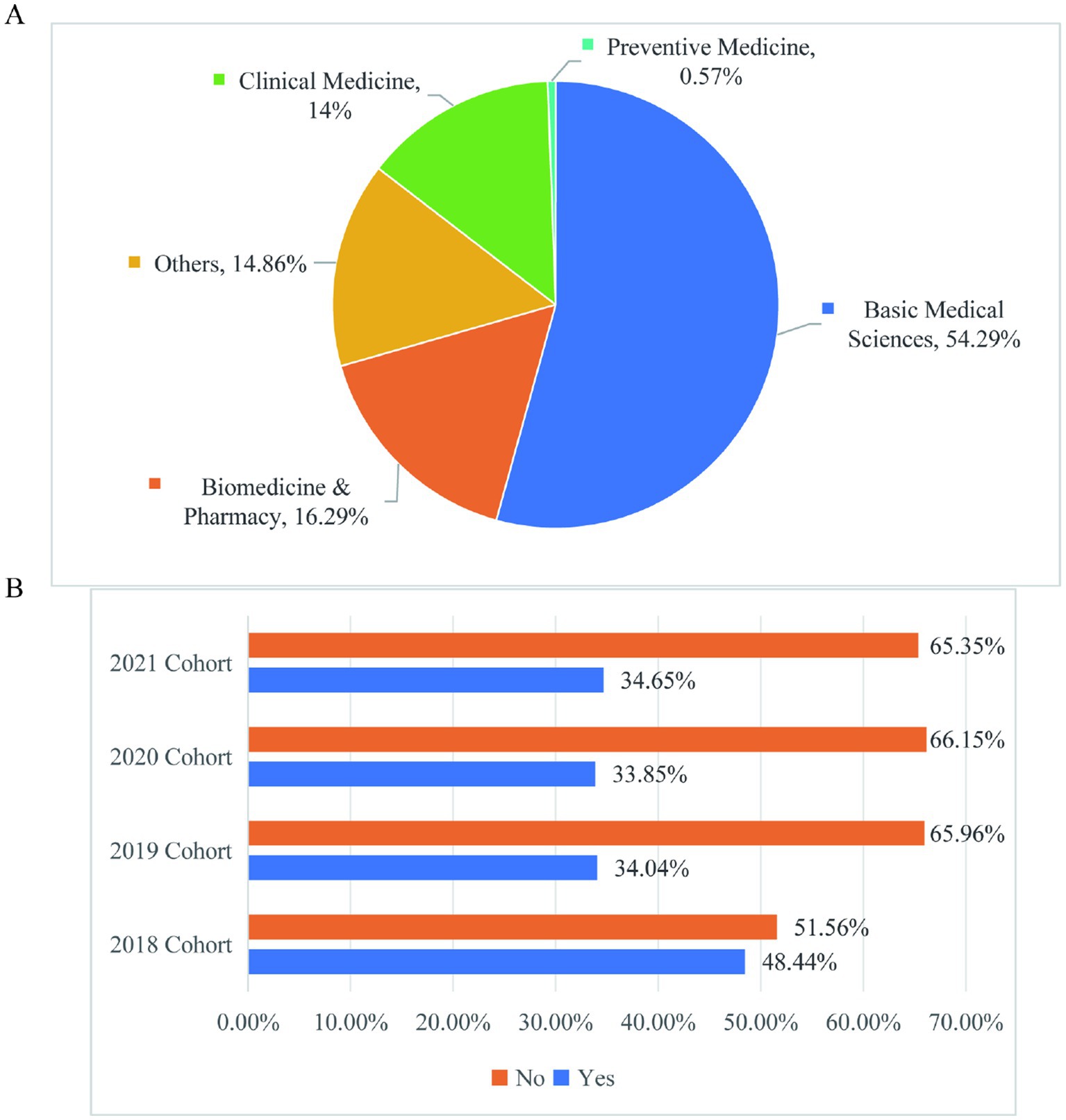
Figure 2. The school structure is diverse. (A) Distribution of undergraduate majors in basic medical research. (B) The proportion of medical graduate students from different grades who have crossed majors.
2.2 Research setting
This study was conducted at the Xiangya School of Basic Medical Sciences, Central South University, which has been designated a National “Top-Tier Undergraduate Training Base in Basic Medical Sciences” by the Chinese Ministry of Education. The school offers research-intensive graduate programs characterized by laboratory-based training and close supervisor–mentee collaboration in the basic medical sciences.
2.3 Participants and sampling
Population: All enrolled graduate students from the 2018, 2019, 2020, and 2021 cohorts.
Sample size achieved: 350 valid questionnaires.
Sampling method: Use WeChat groups to conduct convenient sampling in the form of questionnaire stars.
Inclusion criteria: (1) registered student at the School of Basic Medical Sciences, (2) enrolled between 2018 and 2021.
Exclusion criteria: students on temporary leave or exchange abroad at the time of the survey.
2.4 Data collection procedure
The study utilized a 24-item researcher-developed questionnaire containing both single-choice and multiple-choice formats as well as open-ended questions (Table 1). Although the questionnaire was not formally validated, its items were developed through expert consultation with faculty members. Data were collected via an anonymous online survey distributed through Wenjuanxing (a Chinese platform similar to Qualtrics). Each participant took approximately 5–8 min to complete the survey. Prior to participation, respondents were provided with a detailed explanation of the study’s purpose, and their consent was obtained voluntarily.
2.5 Data analysis strategy
Statistical analyses were conducted using SPSS 18.0. Descriptive statistics (means ± standard deviations) summarized continuous variables. Group comparisons employed independent-samples t-tests, with statistical significance defined as p < 0.05 for all inferential analyses.
2.6 Ethical considerations
The study maintains confidentiality through anonymized data collection and secure server storage. Participants are informed that they have the right to withdraw without penalty.
2.7 Trustworthiness of the study
The study protocol was reviewed and approved by the Institutional Review Board of the School of Basic Medical Sciences, Central South University (Approval No. IRB-2023-KT137). Four measures were taken to enhance the trustworthiness of the data:
• Credibility—all questionnaire items were pilot-tested with target users and refined before formal deployment.
• Dependability—the survey platform automatically generated time-stamped response logs and used IP-address checks to prevent duplicate entries.
• Confirmability—the storage of raw data is only accessible to the research team.
• Transferability—detailed demographic distributions (cohort, gender, disciplinary background) are reported so that readers can judge the applicability of the findings to other contexts.
2.8 Limitations of the methodology
The lack of Likert-scale items constrained nuanced attitude measurement. Self-report bias may affect accuracy of responses regarding sensitive topics like supervisor relationships.
3 Results
3.1 Learning content difficulty perception
In this study, “learning difficulty” refers to challenges in mastering graduate-level academic content (e.g., theoretical knowledge, technical skills) due to gaps in prior training or inadequate pedagogical support, rather than cognitive dysfunction (which falls under clinical learning disabilities). Figure 3 shows that more than 14% of the students think that there is some difficulty in their current study, while only about 10% feel relatively simple (Figure 3A). It can be seen that the proportion of students who find difficulty in learning is relatively high. At the graduate stage, knowledge comes from many sources: (1) subject teaching; (2) active literature and academic reports; (3) practice. Learning is no longer like undergraduate stage, where students passively accept knowledge, but rather actively organize and collect knowledge. However, for students with relatively weak foundation, reading literature is a big problem. Many students cannot understand the literature thoroughly and master the essence of the literature, so they need to actively practice more. Graduate students of different grades in basic medical schools have similar subjective perception of difficulty in learning content (Figure 3B). This finding indicates that the difficulty in learning content is a common issue among graduate students across different cohorts. It is possible that the current teaching methods and curriculum system may not fully meet the needs of students in terms of helping them adapt to the changes in learning style and content. Therefore, there is still room for improvement in the current teaching of educational institutions at all levels. Optimizing the curriculum system and strengthening learning guidance could be of great significance to help students better adapt to the learning changes at the graduate stage.
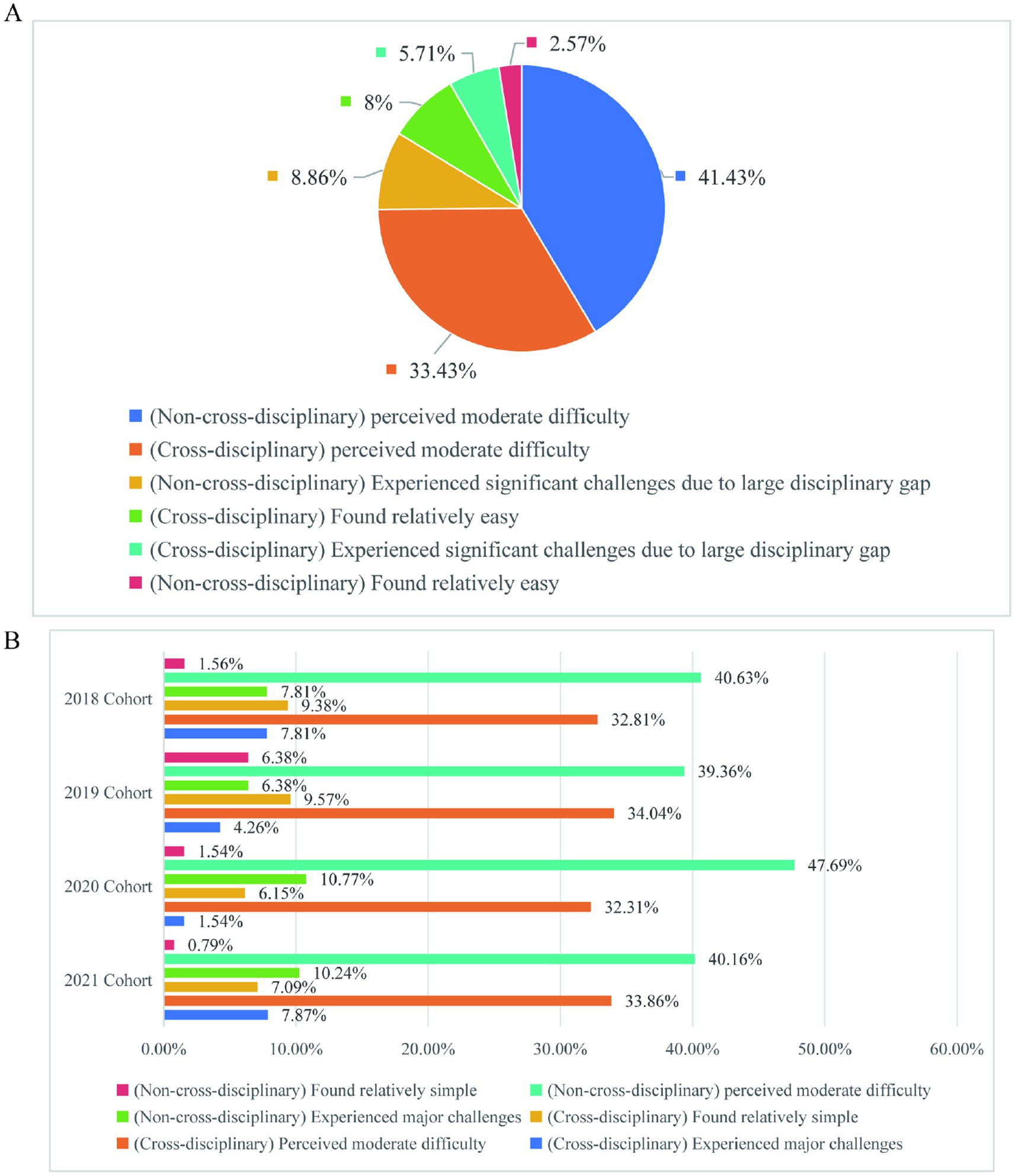
Figure 3. Learning difficulty perception. (A) Perception of the subjective difficulty level of the learning content among graduate students in the School of Basic Medicine. (B) Perception of subjective difficulty level of learning content among graduate students in the School of Basic Medicine at different grades.
3.2 Current situation and problems of graduate student and supervisor exchange
From the survey results, it can be seen that only 30% of graduate students think of seeking help from their supervisors when they encounter difficulties in their studies or life. Most students will ask their friends for help, and a few students will ask their families for help (Figure 4A). In terms of the frequency of communication with supervisors, a few students only communicate with supervisors once a month (Figure 4B). The main reason for less communication with supervisors is that supervisors are busy (Figure 4C). However, it is important to note that there could be multiple factors influencing students’ preferences for seeking help and communication frequency, such as power dynamics, self-directed learning tendencies, and other contextual factors. This indicates that the teacher-student communication mechanisms in China’s educational institutions still require improvement. Establishing efficient communication is crucial for enhancing postgraduate training quality, as it directly impacts academic guidance effectiveness and students’ psychological wellbeing. Future research could explore these factors in more depth to provide a more comprehensive understanding of the underlying issues.
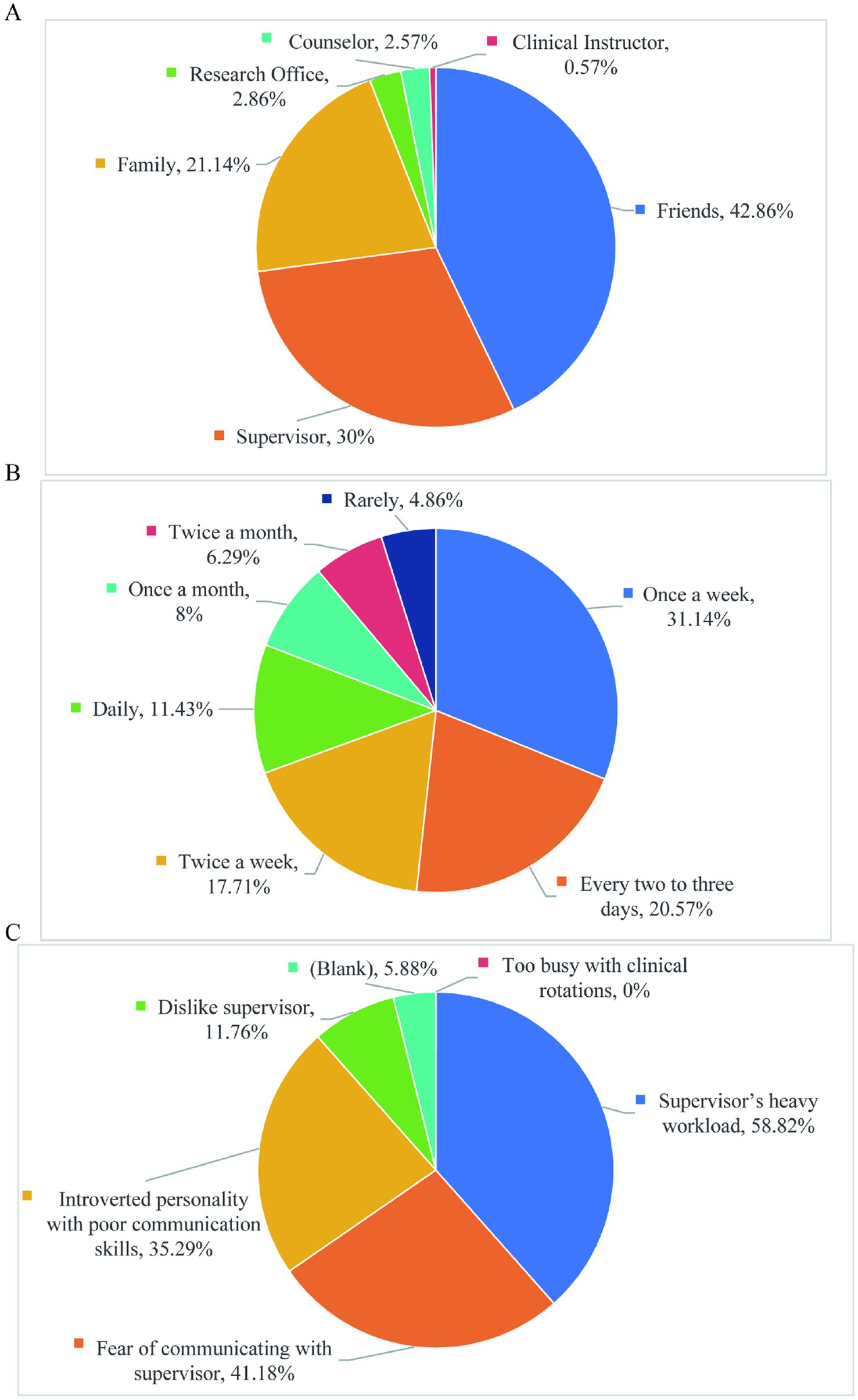
Figure 4. Current situation and problems of graduate student and supervisor exchange. (A) When encountering difficulties in studies or life, graduate students should seek help immediately. (B) Communication between graduate students of basic medicine and their supervisors. (C) Distribution of reasons for limited communication between graduate students and their supervisors.
3.3 Time management model
According to the survey results, about 80% of graduate students have relatively free time schedules, which can be described flexible scheduling, allowing them to complete tasks within defined time periods. This flexible scheduling is particularly conducive to self-directed learning (SDL), a learning approach that has been widely recognized in medical education for its effectiveness in promoting student engagement and efficiency. About 20% of graduate students have relatively tight time schedules, which requires daily fixed-time check-ins (Figure 5). It can be seen that most graduate students have relatively free time schedules. Flexible time schedules enable students to better manage their learning processes, which is essential for SDL. Graduate students can utilize their free time to access research modules and engage in SDL activities. This not only helps them develop critical thinking skills but also prepares them for future professional practice. So how to arrange time reasonably and grasp the balance between study and life is very important. Scientific research requires a lot of time, but scientific research also requires efficiency. Relevant domestic educational institutions shall carry out relevant guidance to guide students to balance scientific research and life, improve time utilization efficiency, form good time management habits, and have an important impact on ensuring the quality of education.
3.4 Analysis of subsistence allowance coverage
Figure 6 shows that only 26% of graduate students believe that the monthly subsidy covers their daily expenses (Figure 6). This financial strain aligns with Maslow’s hierarchy of needs theory, which posits that basic physiological and safety requirements must be satisfied before individuals can pursue higher-order cognitive or self-actualization goals like scientific research (11). Given that graduate students—unlike their employed peers—rely solely on institutional subsidies, unmet subsistence needs may explain observed psychological stressors and reduced research engagement. This result suggests that it is necessary for domestic educational institutions to improve the economic treatment of graduate students and ensure their peace of mind in scientific research, which is a necessary condition for stabilizing graduate students and improving scientific research output.
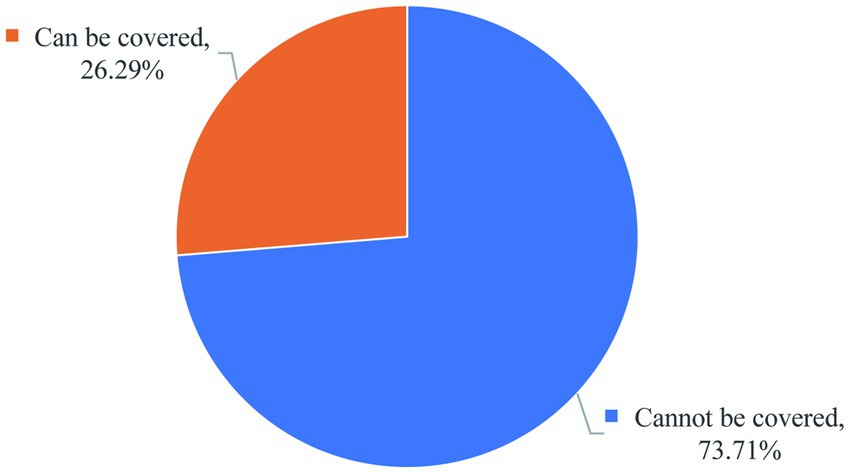
Figure 6. Proportion of graduate students reporting whether their monthly grants/scholarships cover daily expenses.
3.5 Scientific research funding
As can be seen from Figure 7 of the survey results, 26% of graduate students still have insufficient research funding (Figure 7). Basic medical research requires a certain amount of money. Basic medicine is supported by experimental data. A large number of experiments need to be done. These experiments need sufficient funding. This data shows that relevant domestic educational institutions need to increase investment in scientific research funds and optimize the allocation mechanism of funds, which is an important material guarantee for promoting basic medical scientific research innovation and improving graduate students ‘scientific research practice ability.
3.6 Academic participation and influencing factors
54.7% of graduate students attended international or domestic academic conferences, and there is still room for improvement (Figure 8A). Our survey results show that 71.14% of graduate students actively participate in academic activities, and there are still some students who are not motivated to participate in academic activities (Figure 8B). The reasons for insufficient enthusiasm or failure to apply for graduate subjects mainly include the following aspects: Too busy with clinical work, not interested, ignore relevant notifications, lack of adequate research skills, and do not know (Figure 8C). It is recommended that domestic educational institutions formulate relevant policies to enhance the attraction and participation of academic activities. Such measures would be beneficial in broadening students’ academic vision and enhancing their scientific research competitiveness. These initiatives are closely related to the academic growth of graduate students and the improvement of educational quality.
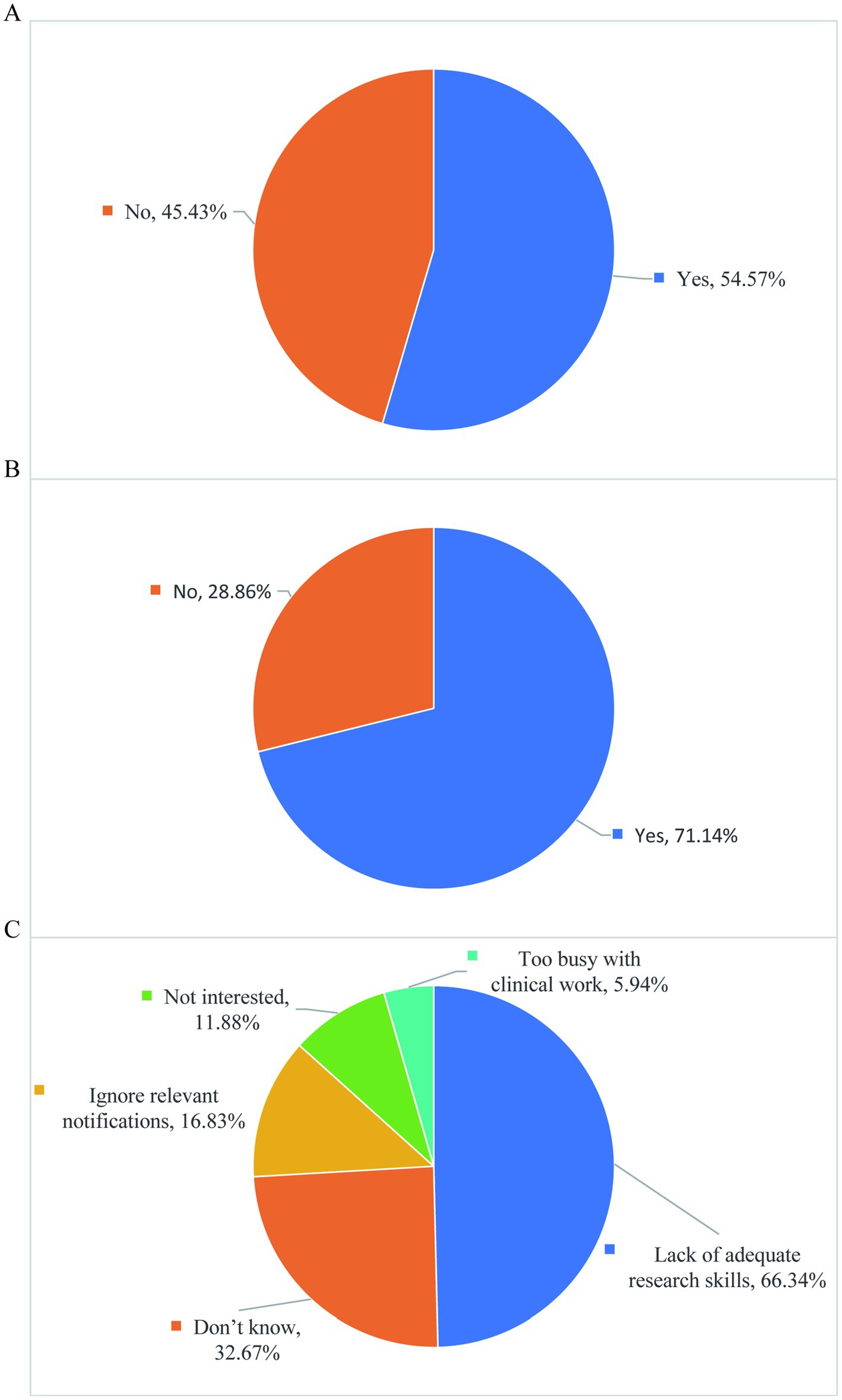
Figure 8. Academic participation and influencing factors. (A) During the training period, did your supervisor arrange for you to attend any international or domestic academic conferences. (B) Are you actively participating in academic activities. (C) Reasons for not participating in academic activities or applying for graduate research topics.
3.7 Current status of scientific research experience before admission
According to the survey results, nearly 1/3 of graduate students have not been exposed to scientific research before entering school, and the proportion of undergraduate graduate students in clinical medicine is higher, and some undergraduate graduate students in other majors have not received scientific research training (Figure 9). Early contact with scientific research, early participation in scientific research projects and integration into scientific research teams are not only conducive to learning scientific research technology in advance, but also conducive to early contact and communication with team members. There are not many opportunities for clinical undergraduates to really contact scientific research, and academic graduate students often start to contact experiments in the second year of graduate students. This survey result provides direction for relevant domestic educational institutions to adjust the connection mechanism between undergraduate and graduate scientific research education, and helps to build a coherent scientific research training system.
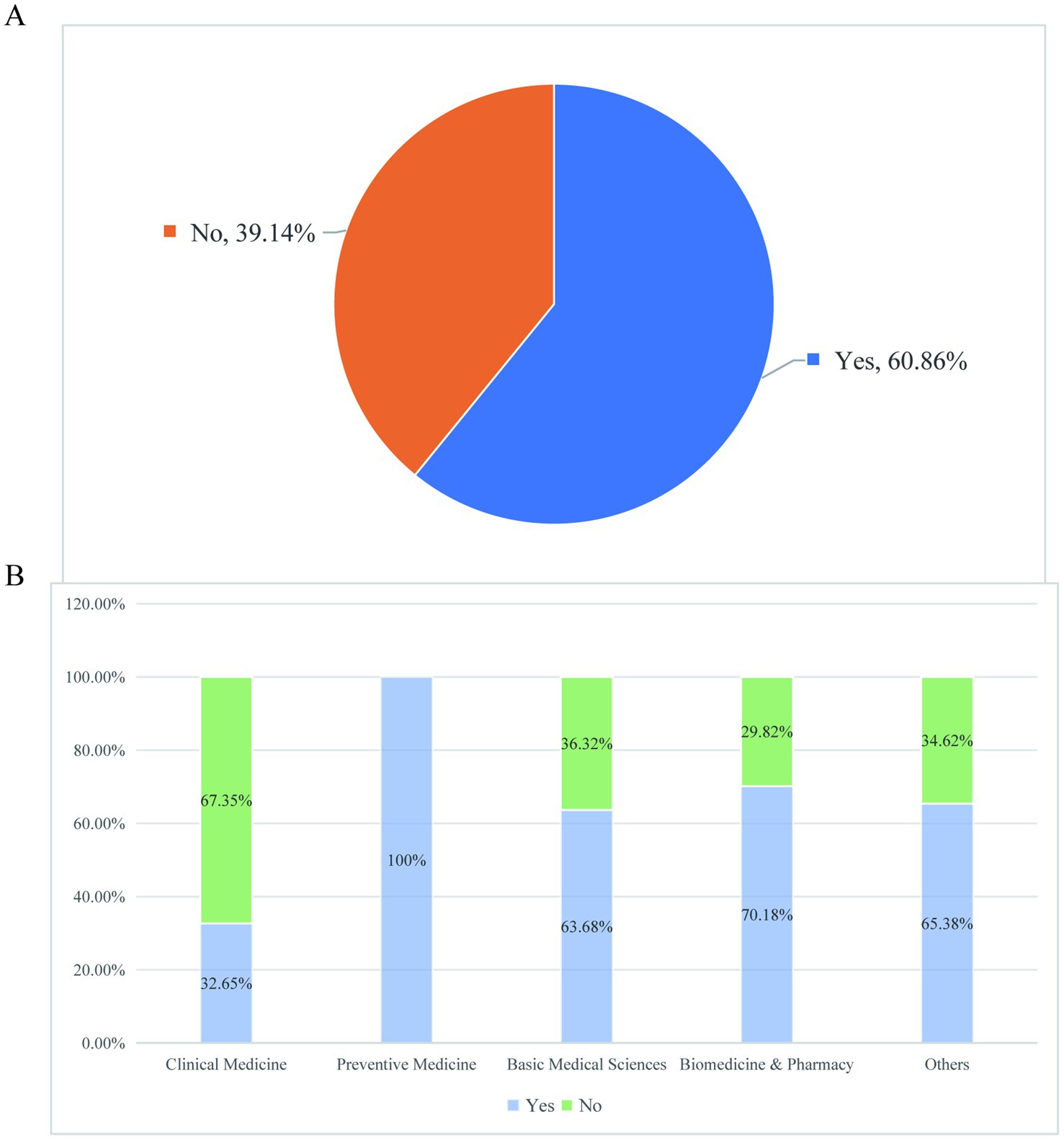
Figure 9. Current status of scientific research experience before admission. (A) The proportion of graduate students who have previously been exposed to research work before admission. (B) The proportion of graduate students in basic medicine from different undergraduate majors who received research training before admission.
3.8 Graduate students’ satisfaction with the academic guidance of their supervisors
Figure 10 of the survey results show that the overall satisfaction of graduate students with the scientific research academic guidance of their supervisors reaches 96.29% (Figure 10A). The proportion of graduate students in different grades who are very satisfied with the scientific research academic guidance of their supervisors exhibits a downward trend with the increase of cohorts (Figure 10B). It is recommended that supervisors pay increased attention to the guidance of senior graduate students. When considering these findings in relation to Figure 8C, it becomes evident that reasons for not participating in research activities include a lack of intrinsic motivation, self-directed learning skills, and possibly time management issues. This suggests that educational institutions at all levels pay attention to the continuous and targeted optimization of supervisor guidance, including fostering intrinsic motivation and self-directed learning skills among graduate students. Establishing a dynamic guidance evaluation mechanism can ensure that graduate students at different stages can obtain high-quality guidance. Additionally, promoting a culture of self-directed learning could help students take more initiative in their research activities, thus improving their satisfaction with academic support from their supervisors.
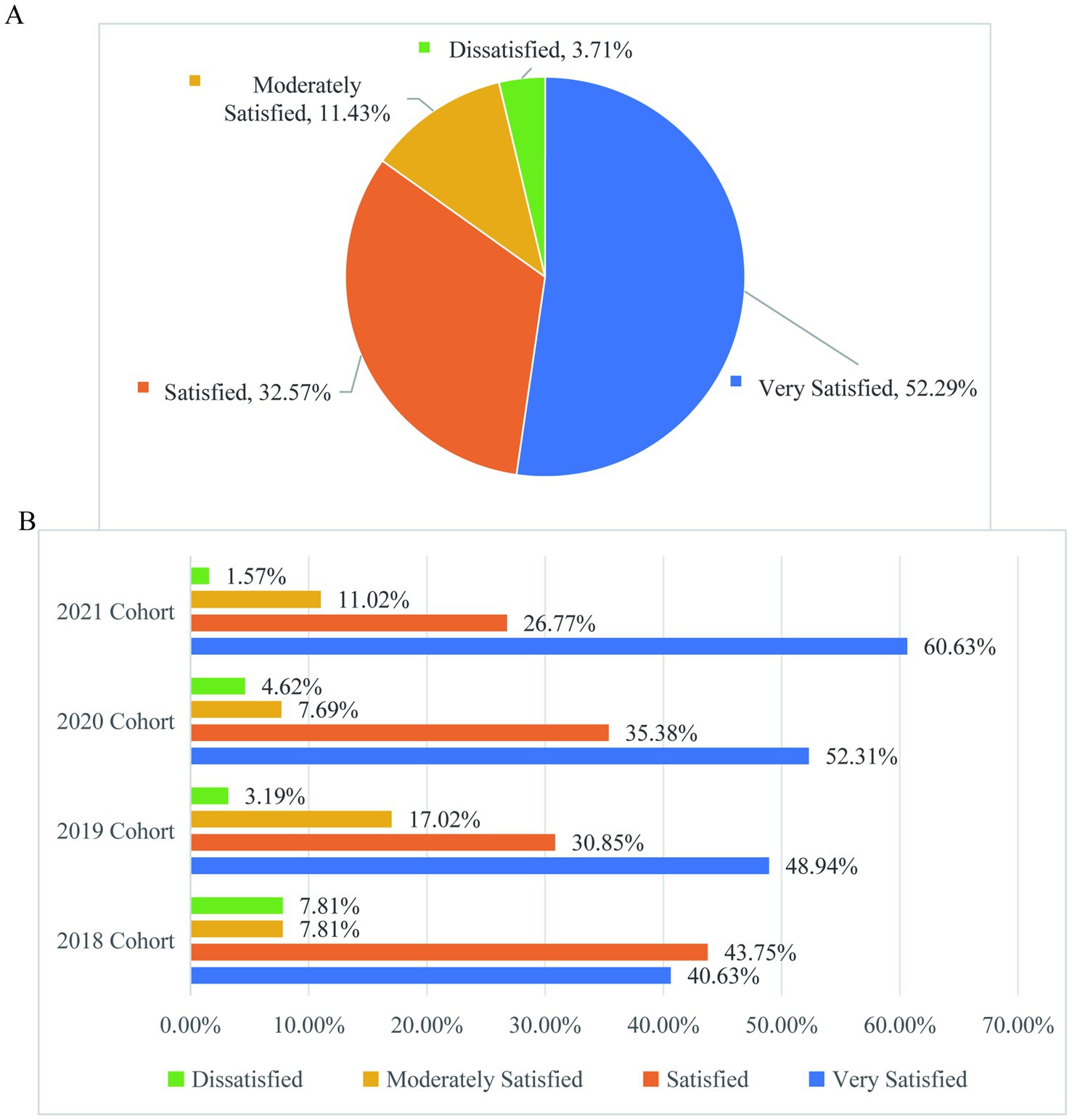
Figure 10. Graduate students’ satisfaction with the academic guidance of their supervisors. (A) Distribution of satisfaction levels among graduate students regarding academic guidance from their supervisors. (B) Distribution of satisfaction levels among graduate students of different grades regarding their advisors’ research and academic guidance.
3.9 Graduate student team work atmosphere satisfaction and difference analysis
Figure 11 of the survey results show that 86.57% of the overall graduate students like the working atmosphere of their group (Figure 11A), and the difference in the proportion of graduate students in different grades like the working atmosphere of their group is reflected in the graduation cohort (2019 cohort) (Figure 11B); greater attention should be paid to students’ life, research, and future career or academic pathways of graduate students in graduation grade. Good team atmosphere is an important factor to improve graduate research efficiency and mental health. This study provides evidence for educational institutions at all levels to optimize team building strategies and pay attention to the special needs of graduate students.
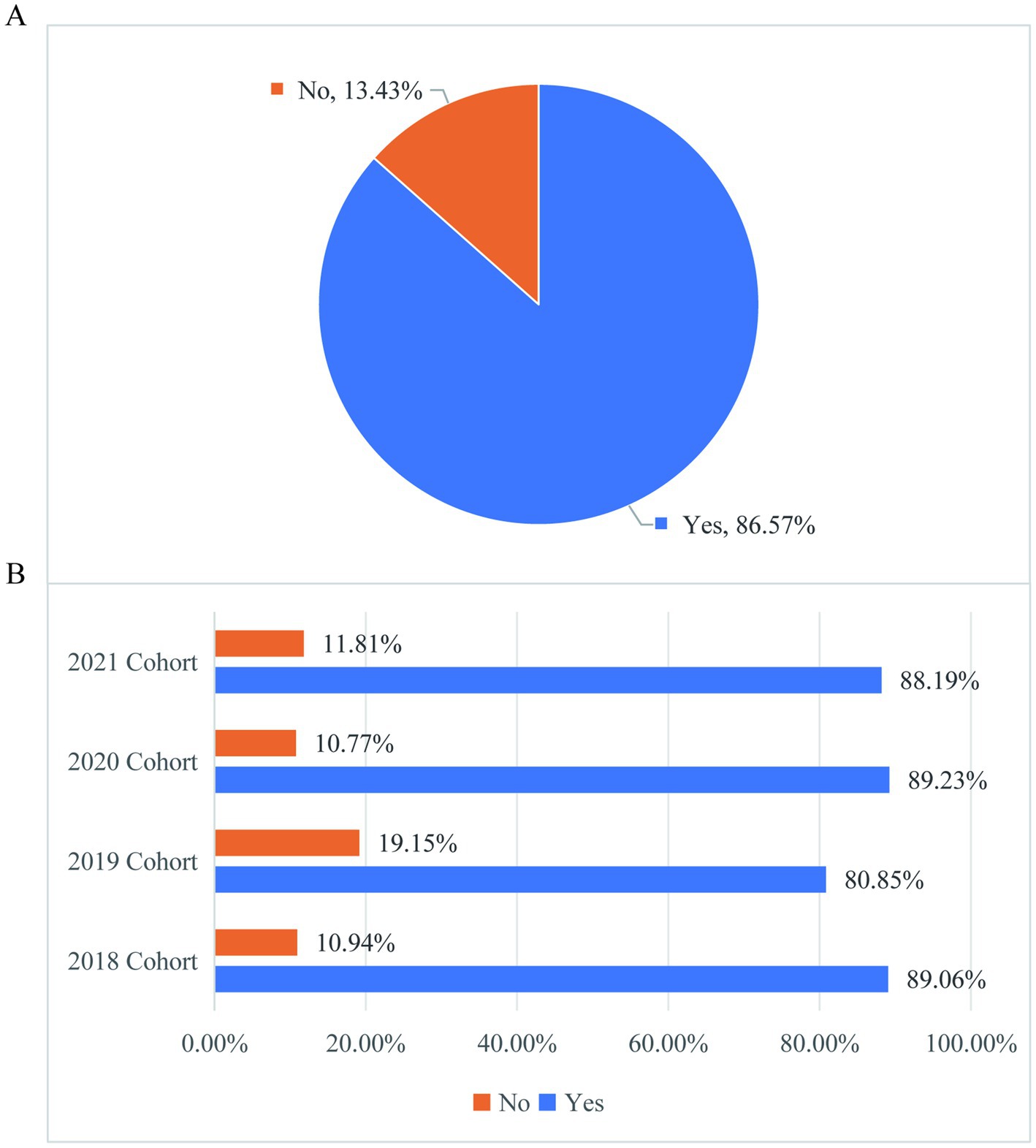
Figure 11. Graduate student team work atmosphere satisfaction and difference analysis. (A) Distribution of the proportion of graduate students who like the working atmosphere of their current group. (B) The distribution of the proportion of graduate students in different grades who like the work atmosphere of their current group.
3.10 Graduate students’ overall satisfaction with their current graduate life
Figure 12 of the survey results show that the overall dissatisfaction rate of graduate students with the current graduate life is 20.86%, the dissatisfaction rate of graduate students in different grades with the current graduate life is not different by about 20%, and the graduation grade (2018 cohort) has decreased (15.63%) (Figure 12). Therefore, educational institutions at all levels comprehensively improve graduate students’ life satisfaction, involving comprehensive improvement in many aspects of life, study and scientific research, which is the key to creating a high-quality educational ecology and attracting and retaining outstanding talents.
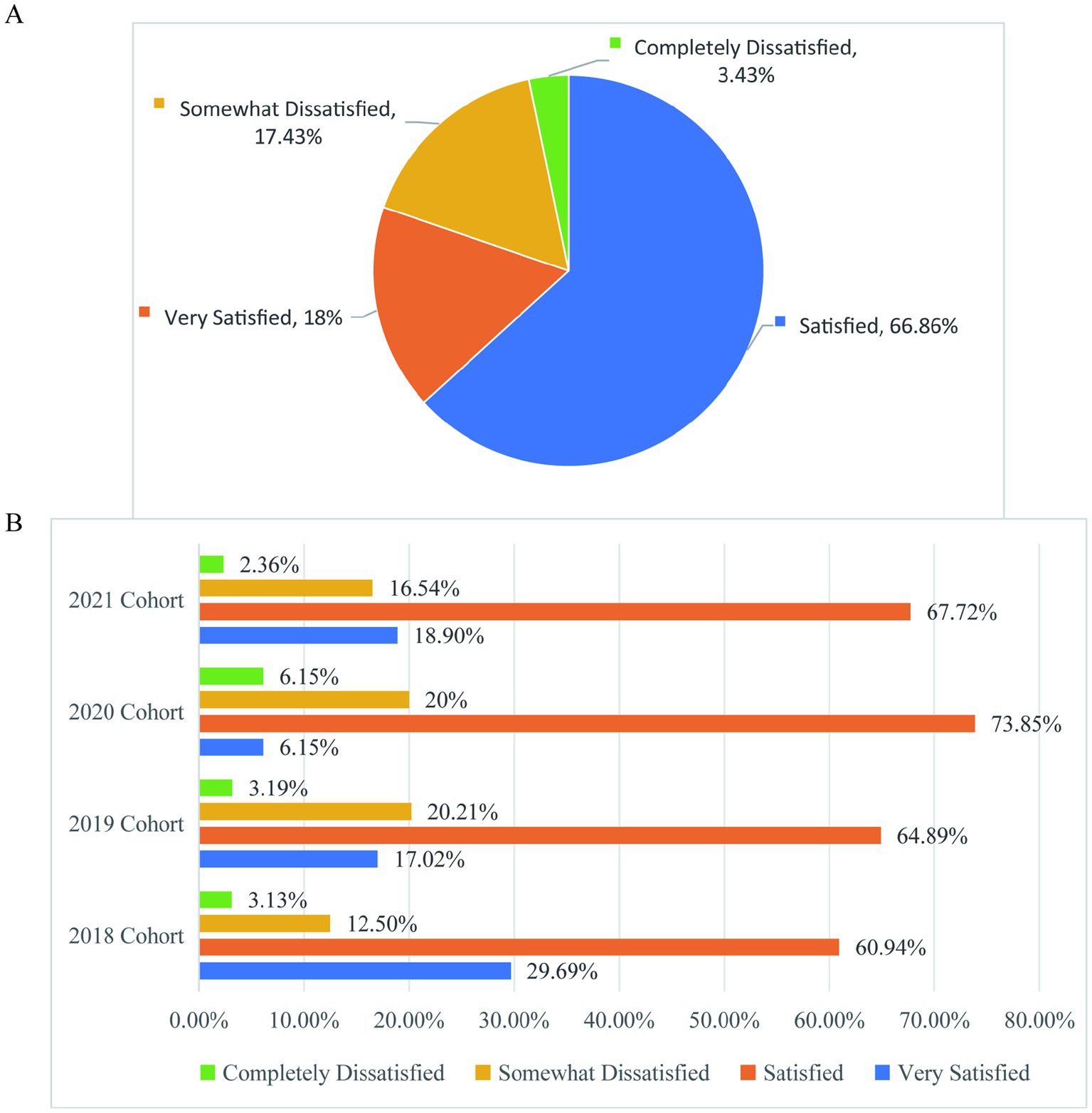
Figure 12. Graduate student’s overall satisfaction with their current graduate life. (A) The satisfaction of graduate students with their current graduate student life. (B) Satisfaction of graduate students from different grades with their current graduate life.
4 Recommendations and countermeasures
4.1 Enhance graduate student adaptation and academic experience
To enhance their academic experience and adapt more effectively to their new environment, graduate students can implement several proactive strategies. These include embracing SDL, which empowers students to take charge of their educational journey and develop critical thinking skills (12). Additionally, fostering intrinsic motivation can drive students to engage more deeply with their studies and research (13). Seeking academic support early is crucial, as it helps to address challenges promptly and leverage available resources. Engaging in peer learning and networking not only provides a platform for mutual support and knowledge exchange but also enhances students’ social integration and professional development.
4.2 Actively guide graduate students to adjust their mentality and adapt to their majors
It is recommended that schools, colleges, and supervisors establish mechanisms to guide graduate students with multi-disciplinary backgrounds to adapt to graduate studies as soon as possible. It is suggested that supervisors actively listen to students, adjust expectations appropriately, and build trust while providing academic guidance (14, 15), and gradually adjust to the transition in graduate school in a positive mood (16).
From undergraduate to graduate students, graduate students need to change their learning thinking mode, actively learn, adjust their mentality, adapt to their majors (17), build a solid psychological and knowledge foundation for subsequent learning and scientific research, and provide demonstrations for relevant educational institutions at all levels to deal with students ‘professional adaptation problems.
4.3 Establish multiple communication channels, strengthen information exchange, and timely discover and solve problems
Establish mechanisms at school and college levels to ensure that supervisors have sufficient time to guide graduate students.
Supervisors invest more time and energy in graduate students: In the process of scientific research, timely and effective information exchange is extremely important (18, 19). This kind of communication is two-way, the supervisor needs to keep abreast of the student’s work progress, and the student needs to get corresponding help from the supervisor (20, 21).
Graduate students are proactive: The supervisor is busy with work, so it is encouraged that graduate students think about what problems they need to solve before communicating with the supervisor, and how to solve the problems. When communicating with the supervisor, try to save time and solve the problems efficiently (22). For introverted students who are not good at communication, they should try their best to improve their ability to express themselves, dare to ask questions, not afraid of mistakes, not afraid of criticism, always have an apprentice mentality, consult with supervisors modestly, try to consult face-to-face, and solve problems in writing when necessary; For those students who do not like supervisors and are afraid to communicate with supervisors, it is preferable that they carefully consider whether they understand their supervisors clearly and are really interested in their research direction. If necessary, they can apply to the school for replacement of supervisors.
In medical education, critical thinking and problem-solving skills are essential (23). It is suggested that supervisors pay more attention to guiding students to actively discover problems and actively seek solutions (24).
4.4 Reasonable arrangement of time, balance between scientific research and life
Besides scientific research, how to live happily is also a very important thing. Many graduate students often complain about the difficulty of scientific research, which makes it difficult to balance the contradiction between scientific research and life (25), which leads to many graduate students having mental health problems (26, 27). There is a need for graduate students to formulate detailed study and research plans, clarify task priorities, and ensure efficient completion of work.
Learn to set time for rest and relaxation, avoid overwork, actively participate in social activities, expand interpersonal networks, relieve scientific research pressure, and achieve a balance between scientific research and life (28).
4.5 Increase funding at multiple levels to solve worries and ease scientific research
The state, society, schools, colleges and supervisors invest more funds through multiple channels to improve the treatment of graduate students and ensure the life and scientific research of graduate students (29). Improve the fund management and supervision mechanism to ensure the rational distribution and use of funds, and provide an example for the construction of fund guarantee mechanism for education-related institutions at all levels.
4.6 Build platforms, actively participate in academic activities and broaden their horizons
Increase the enthusiasm of graduate students to participate in academic activities or submit projects (30, 31). Colleges and universities can improve the overall level of scientific research and teaching by building innovation platforms and academic heights and optimizing evaluation and incentive mechanisms (32, 33). At the same time, we will expand academic publicity, improve the content of academic activities, and increase the benefits of applying for projects, so as to improve the initiative of graduate students.
Graduate students are encouraged to actively engage in academic activities and research projects aligned with their professional interests, thereby enhancing their academic competence, career development, and personal growth through increased self-directed initiative (34).
With the strong support of the state for scientific research, the speed of scientific and technological development in China is constantly improving, the level of scientific research is constantly improving, various new scientific research achievements are changing with each passing day, and many graduate textbooks are not updated in time, introduced comprehensively, and the content is not deep. Graduate students’ daily study is different from undergraduate study. During their study, graduate students will have various academic lectures, conferences and opportunities for exchange and study. In addition to completing experimental tasks in the laboratory every day, it is preferable that basic medical graduate students actively participate in professional-related learning and enrich themselves through various channels. Extensive communication can play a positive role in releasing the pressure brought by the subject and solving professional problems during graduate school. At the same time, active contact with the forefront of scientific research is conducive to the cultivation of scientific research thinking, the expansion of knowledge, the improvement of learning and inquiry ability and the cultivation of scientific research interest (35).
4.7 Early contact with scientific research and adaptation to scientific research roles
In addition to the study of basic courses, Yanyi makes good use of spare time, reads a lot of relevant literature, actively participates in subject research, and learns experimental techniques in advance, which is of great help to enter the laboratory and participate in scientific research activities quickly in the future (36).
For graduate students who have just come into contact with scientific research, it is also indispensable for supervisors to give more patient and specific guidance, reasonably arrange literature reading tasks, regularly assess learning effects (37), and provide practical paths for the early cultivation of scientific research talents in domestic colleges and universities.
4.8 Strengthen graduate student guidance, attach importance to team building, and make efforts to improve graduate student satisfaction by “four-in-one”
Supervisors are the first responsible person for postgraduate training. Supervisors strengthen their own learning (38), attach importance to life care and academic guidance for graduate students; schools and colleges give supervisors training and promotion opportunities (39, 40).
The ideal academic environment is considered to prepare students for future efforts, development, and social well-being (41). Competitive, stressful, threatening, or authoritative environments de-motivate students, while collective, collaborative, and supportive environments are motivating factors (42). It may be useful for supervisors to pay attention to the creation of a good atmosphere within the scientific research team, good interpersonal relations, a united and cooperative team, and an upward scientific research atmosphere (43, 44); schools and colleges should create a wide range of good academic atmosphere.
Actively implement the double supervisor system (45, 46), broaden the vision of graduate students, improve their practical ability, and lay a solid foundation for graduate research and career development (47).
Implement the four-in-one postgraduate training mechanism of “school, college, discipline and supervisor,” pay attention to the whole process of postgraduate “life, psychology, study, scientific research and future development” (48), and provide a model for innovation of postgraduate training mode in educational institutions.
5 Discussion
Our study reveals several critical findings regarding the cultivation of top-tier basic medical graduate students under China’s “Basic Discipline Top-Student Training Program 2.0.”
The mentor-mentee relationship emerges as a crucial factor in graduate education (49). Only 30% of students prioritize seeking guidance from their supervisors when encountering difficulties, and satisfaction with mentorship shows a declining trend among senior students. This phenomenon likely reflects a mismatch between supervisors’ expectations of greater research autonomy for advanced students and their actual guidance approaches (50). Notably, despite high overall satisfaction with supervisors’ guidance and regular access to supervisors (80.85% reported meeting at least once a week), a significant number of students still encounter learning difficulties and prefer seeking help from peers. This suggests that while supervisor support is generally available, students may face internal barriers to effective communication. These barriers could include personal characteristics such as introversion, poor communication skills, or fear of communication, rather than issues with the supervisors themselves.
Financial constraints represent another significant challenge. Our data indicates that 26.29% of students struggle with inadequate living stipends, while 26.29% face insufficient research funding—a situation at odds with national policies advocating for improved graduate student support. These financial pressures are particularly detrimental in basic medical research (51), where experimental costs are substantial, and may force students to take on part-time work, compromising their research engagement.
The study also uncovers a concerning cycle of research skill development: 66.34% of students avoid academic activities due to perceived competence gaps, exacerbated by the fact that nearly two-thirds enter graduate programs without prior research experience. While 86.57% of students report positive team environments, satisfaction declines among graduation-year cohorts, highlighting the psychological challenges associated with the long, uncertain research cycles characteristic of basic medical science (52).
These findings collectively reflect implementation gaps in localizing the national “Top-Student Training Program 2.0” policy, particularly in resource allocation and policy execution. As a designated national training base for elite basic medical students, Central South University’s experience offers valuable insights.
Under the background of the national vigorous implementation of “Basic Top-notch 2.0” (53), how to comply with policies, make good use of policies, overcome systemic challenges, and cultivate top-notch Basic scientific research talents who are expected to lead the development of basic medicine in China, and achieve future breakthroughs in scientific frontiers? As important bearers of glorious mission, basic medical graduate students play an important role. It is recommended that the state, society, educational institutions, and supervisors gain a deeper understanding of the life, study, and scientific research experiences of graduate students. It is advisable to target their specific needs and establish comprehensive support mechanisms that encompass various aspects such as daily life, academic pursuits, and research activities (28, 54). Additionally, it would be beneficial to create follow-up channels that align with their further study and development aspirations, ensuring that they receive the necessary assistance and guidance (55). Let the training mode be more perfect, the training mechanism be more perfect, the leading and demonstration role of the training plan for top students in basic disciplines be more prominent, form a training system for top talents in basic medical disciplines with China characteristics and world-class level, cultivate a group of outstanding talents who bravely climb the scientific peak and promote the development of basic medicine in China, and inject continuous innovation power into the vigorous development of medical cause in China.
Data availability statement
The original contributions presented in the study are included in the article/supplementary material, further inquiries can be directed to the corresponding author.
Ethics statement
Ethical approval was not required for the study involving humans in accordance with the local legislation and institutional requirements. Written informed consent to participate in this study was not required from the participants or the participants’ legal guardians/next of kin in accordance with the national legislation and the institutional equirements.
Author contributions
QZ: Visualization, Investigation, Data curation, Writing – original draft, Conceptualization, Software. XY: Investigation, Methodology, Supervision, Validation, Funding acquisition, Writing – original draft, Writing – review & editing. ZL: Methodology, Software, Project administration, Writing – original draft. JL: Conceptualization, Writing – original draft, Data curation. DO: Formal analysis, Writing – original draft. JW: Methodology, Validation, Supervision, Writing – original draft, Funding acquisition, Writing – review & editing, Investigation.
Funding
The author(s) declare that financial support was received for the research and/or publication of this article. This work was partially supported by 2022 Annual Central South University Degree and Postgraduate Education Teaching Reform Research (General Project 70), the Open Project of Xiangjiang Laboratory (23XJ03001), the Scientific Research Program of Furong Laboratory (no. 2024PT5111), the Key Project for Teaching Reform of Central South University in 2025 (2025jy052-4), and the Science and Technology Planning Project of Guangdong Province (2023B1212060013, 2020B1212030004). Moreover, we appreciate laboratory members for their thoughtful suggestions and comments on the manuscript.
Acknowledgments
We thank all authors for making improvements to this manuscript.
Conflict of interest
The authors declare that the research was conducted in the absence of any commercial or financial relationships that could be construed as a potential conflict of interest.
Generative AI statement
The authors declare that no Gen AI was used in the creation of this manuscript.
Any alternative text (alt text) provided alongside figures in this article has been generated by Frontiers with the support of artificial intelligence and reasonable efforts have been made to ensure accuracy, including review by the authors wherever possible. If you identify any issues, please contact us.
Publisher’s note
All claims expressed in this article are solely those of the authors and do not necessarily represent those of their affiliated organizations, or those of the publisher, the editors and the reviewers. Any product that may be evaluated in this article, or claim that may be made by its manufacturer, is not guaranteed or endorsed by the publisher.
References
1. Ministry of Education of the People’s Republic of China. Outline of the national plan for medium and long-term education reform and development (2010–2020). Ministry of Education (2010). Available online at: http://www.moe.gov.cn/srcsite/A01/s7048/201007/t20100729_171904.html
2. Ministry of Education of the People’s Republic of China. National program for medium and long-term talent development (2010–2020). (2010). Available online at: http://www.moe.gov.cn/jyb_xwfb/s6052/moe_838/201006/t20100607_88754.html
3. Academic Affairs Offices of Tsinghua University, Nanjing University, Sichuan University. The first four-year report on the pilot program for training outstanding students in the basic sciences. Beijing: Higher Education Press (2015).
4. Xi, JP. Strengthen grassroots work to solidify the foundation of social harmony. Qiushi. (2006) 21:22–4. https://d.wanfangdata.com.cn/periodical/ChVQZXJpb2RpY2FsQ0hJMjAyNTA2MjISDXFpdXMyMDA2MjEwMDYaCG4zZngxOWR0
5. Xie, T. Research on the mode of the changes of China’s top talents cultivation policy. Lanzhou: Lanzhou University (2023).
6. Chen, SY, Zeng, Y, and Li, LR. Cultivating top-notch talents based on basic disciplines—selected colleges and universities of top-notch plan 2.0. Coll Admis. (2021) 5:70–3. doi: 10.3969/j.issn.1671-2293.2021.05.026
7. You, SH, Zhou, JZ, Li, J, Kong, MH, and Tan, WH. Practice and reflection on cultivating top-notch innovative talents in life sciences and medicine. Bull Chin Acad Sci. (2025) 40:260–72. doi: 10.16418/j.issn.1000-3045.20241106001
8. Zhang, X, Wang, JP, Zhou, WH, Wang, S, Xiang, Y, Sun, SY, et al. Research adaptation and team building of basic medicine from the perspective of graduate students. Educ Teach Forum. (2020) 34:212–4. https://d.wanfangdata.com.cn/periodical/ChVQZXJpb2RpY2FsQ0hJMjAyNTA2MjISD2p5anhsdDIwMjAzNDA5MhoIeXloaHVjcXA%3D
9. Asokan, S, Pollachi Ramakrishnan, G, Ranganatham, KV, Viswanath, S, and Sivasamy, S. Stress amongst paediatric dental postgraduate students in India: a mixed-method approach. Eur J Dent Educ. (2022) 26:629–38. doi: 10.1111/eje.12740
10. Song, S, Zhou, XC, Chen, D, Ren, GF, and Chen, JX. Exploring an international joint training model for eight-year medical students at Xiangya School of Medicine, Central South University. Chin J Med Educ. (2024) 44:801–4. doi: 10.3760/cma.j.cn115259-20240327-00319
11. Sharma, MK, Chaturvedi, SK, and Suma, N. Technology use expression of Maslow’s hierarchy need. Asian J Psychiatr. (2020) 48:101895. doi: 10.1016/j.ajp.2019.101895
12. Robinson, JD, and Persky, AM. Developing self-directed learners. Am J Pharm Educ. (2020) 84:847512. doi: 10.5688/ajpe847512
13. DePasque, S, and Tricomi, E. Effects of intrinsic motivation on feedback processing during learning. Neuroimage. (2015) 119:175–86. doi: 10.1016/j.neuroimage.2015.06.046
14. Davis, JS, Sakwe, AM, Ramesh, A, Lindsey, ML, and Woods, L. How to be a GREAT mentor. Adv Physiol Educ. (2023) 47:584–8. doi: 10.1152/advan.00054.2023
15. Fu, ZN. Research on the adaptation process and influencing factors of mentor role of young teachers in colleges and universities. Tianjin: Tianjin University (2023).
16. Yang, D. EFL/ESL students’ perceptions of distributive, procedural, and interactional justice: the impact of positive teacher-student relation. Front Psychol. (2021) 12:755234. doi: 10.3389/fpsyg.2021.755234
17. Qi, R. (2023). Research on postgraduates’ academic adaptation. Shanghai: Shanghai Normal University.
18. Jarrett, O, Humaidan-Zayed, L, Chamberlain, S, and Weine, S. Strengthening mentorship in Global Health for US medical students. Ann Glob Health. (2023) 89:61. doi: 10.5334/aogh.4106
19. Fu, SQ, Wu, WS, Xiao, Y, and Zhou, XY. Investigation on the teacher-student relationship in graduate education. Basic Med Educ. (2019) 21:906–11. doi: 10.13754/j.issn2095-1450.2019.11.23
20. Sarabipour, S, Hainer, SJ, Arslan, FN, de Winde, CM, Furlong, E, Bielczyk, N, et al. Building and sustaining mentor interactions as a mentee. FEBS J. (2022) 289:1374–84. doi: 10.1111/febs.15823
21. Chen, HR, Hu, JB, Wen, YY, Ji, YT, Chen, JF, and Chen, SH. Survey on the mentoring relationship between mentor and medical postgraduates in an affiliated hospital of a certain university from the perspective of students. Chin J Med Educ. (2024) 44:203–6. doi: 10.3760/cma.j.cn115259-20230320-00289
22. Diao, L. (2008). Study on the present situation and improving methods of communication between graduate students and advisor. Chongqing University. Available online at: https://d.wanfangdata.com.cn/thesis/ChhUaGVzaXNOZXdTMjAyNDA5MjAxNTE3MjUSB0QzMjE3NjgaCGQyNG14d2Fs
23. Liu, JH. Research on innovative service measures of research practice education in medical university libraries. Comparat Res Cult Innov. (2024) 8:190–3+198. https://d.wanfangdata.com.cn/periodical/ChVQZXJpb2RpY2FsQ0hJMjAyNTA2MjISGlFLQkpCRDIwMjQyMDI1MDIyNDAwMDA2NDgxGghzeGM5d3B6ZA==
24. Chen, JL, Wang, N, and Bi, XQ. Theoretical and practical exploration of medical education reform research: a review of introduction to medical education research. Sci Technol Manag Res. (2023) 43:250. doi: 10.3969/j.issn.1000-7695.2023.08.035
25. Wang, JJ. The value and strategy of strengthening the leisure time management of master’s students in colleges and universities. Cult Educ Mater. (2012) 2:184–5. doi: 10.3969/j.issn.1004-8359.2012.02.097
26. Chi, T, Cheng, L, and Zhang, Z. Global prevalence and trend of anxiety among graduate students: a systematic review and meta-analysis. Brain Behav. (2023) 13:e2909. doi: 10.1002/brb3.2909
27. Crone, WC, Kesebir, P, Hays, B, Mirgain, SA, Davidson, RJ, and Hagness, SC. Cultivating well-being in engineering graduate students through mindfulness training. PLoS One. (2023) 18:e0281994. doi: 10.1371/journal.pone.0281994
28. Busch, CA, Wiesenthal, NJ, Gin, LE, and Cooper, KM. Behind the graduate mental health crisis in science. Nat Biotechnol. (2024) 42:1749–53. doi: 10.1038/s41587-024-02457-z
29. Zhang, X, Huang, Z, Li, X, and Zeng, XY. Satisfaction of full-time postgraduate education in clinical medicine from the perspective of postgraduate students. Chin Med Educ. (2020) 9:127–8+132. doi: 10.3969/j.issn.1002-1701.2020.09.065
30. Wang, WC, Jiang, ZL, and Song, FM. Research on improving the scientific research level of basic medical postgraduates in medical colleges and universities in Western China. Forum Educ Teach. (2022) 22:177–80. https://d.wanfangdata.com.cn/periodical/ChVQZXJpb2RpY2FsQ0hJMjAyNTA2MjISD2p5anhsdDIwMjIyMjA0NRoIdWE4OHR3YWM=
31. Wang, P, Chen, YX, and Li, SQ. Research on the reform of medical postgraduate training mode under the background of new medicine. Forum Educ Teach. (2023) 9:56–9. https://d.wanfangdata.com.cn/periodical/ChVQZXJpb2RpY2FsQ0hJMjAyNTA2MjISD2p5anhsdDIwMjMwOTAxNBoINDdxemEzMnI=
32. Wu, HY, Li, ZQ, and Tang, LF. Reflections on science research publicity of medical colleges and universities in the new era. Chin J Med Sci Res Manage. (2023) 36:469–74. doi: 10.3760/cma.j.cn113565-20230309-00064
33. Yan, XX. Reflections on the cultivation of outstanding young medical talents in the new era. Chine Sci Fund. (2024) 38:557–8. https://d.wanfangdata.com.cn/periodical/ChVQZXJpb2RpY2FsQ0hJMjAyNTA2MjISD3pna3hqajIwMjQwMzAzMhoIMndrZ294aDU=
34. Kim, S, Jeong, H, Cho, H, and Yu, J. Extracurricular activities in medical education: an integrative literature review. BMC Med Educ. (2023) 23:278. doi: 10.1186/s12909-023-04245-w
35. Siddique, U, Mahboob, U, Mahsood, N, Mehboob, B, Abdullah, AS, and Baseer, M. Adaptation and modification of the professional identity formation scale for postgraduate trainees in basic health science: a mixed method study. BMC Med Educ. (2025) 25:475. doi: 10.1186/s12909-025-07025-w
36. Shu, XS, Ai, XQ, Liu, WJ, Zhang, XJ, Kun, XC, Chen, S, et al. Construction of the training system of “one body, two wings” to cultivate innovative postgraduates of basic medicine. Basic Med Educ. (2024) 26:807–10. doi: 10.13754/j.issn2095-1450.2024.09.17
37. Yang, YY, Bin, XY, Huang, XF, Wang, JC, and Jian, CD. Exploration on the “dual Mentor system” in cultivation of graduate students majored in basic medicine under the background of collaborative innovation. Health Vocat Educ. (2024) 42:4–7. doi: 10.20037/j.issn.1671-1246.2024.16.02
38. Zheng, Y, Han, YY, and Li, ZM. Review and prospect of research on postgraduate tutor ability in China (1997-2020). J Univ Sci Technol Beijing. (2022) 38:130–7. doi: 10.19979/j.cnki.issn10082689.2021120059
39. Huyan, TH (2020).Research on internal guarantee system and improvement mechanism of postgraduate education quality. Shaanxi: Xi’an University of Architecture and Technology. Available online at: https://d.wanfangdata.com.cn/thesis/CiBUaGVzaXNOZXdTMjAyNTA2MTMyMDI1MDYxMzE2MTkxNhIJRDAyMjk5NjY0GghlczFwbTZ6Mw%3D%3D
40. Xiong, XQ, Zhang, F, Wang, JJ, and Chen, L. Discussion on the cultivation path of scientific research innovation ability of basic medical graduate students under the background of “double first-class". Sci Technol Educ. (2022) 36:4–6. doi: 10.16400/j.cnki.kjdk.2022.36.002
41. Mahsood, N, Mahboob, U, Asim, M, and Shaheen, N. Assessing the well-being of PhD scholars: a scoping review. BMC Psychol. (2025) 13:362. doi: 10.1186/s40359-025-02668-2
42. Chellaiyan, VG, Bhushan, K, Maruthupandian, J, Gupta, S, Liaquathali, F, and Jenniferbritto, J. Perception of the educational environment and its impact on the academic performance of medical school students: a cross-sectional study. Maedica. (2023) 18:80–7. doi: 10.26574/maedica.2023.18.1.80
43. Zhu, QR, Liu, MQ, Jia, JZ, Zhu, R, Yan, Q, Wen, MY, et al. Study on the relationship between supervisors’ guidance and the personal ability of postgraduates in the professional master’s program in clinical medicine: role of learning engagement and learning burnout. Chin J Med Educ Explor. (2024) 23:1161–8. doi: 10.3760/cma.j.cn116021-20231226-01834
44. Zhou, WW, Xie, YJ, and Lin, CH. Influencing factors and countermeasures of graduate training quality from the perspective of mentors. China Higher Educ. (2020) 10:52–3. https://d.wanfangdata.com.cn/periodical/ChVQZXJpb2RpY2FsQ0hJMjAyNTA2MjISD3pnZ2RqeTIwMjAxMDAyMBoIMTJ5Z3M3NGk=
45. Ministry of Education. Opinions on the implementation of the excellence in teacher training program 2.0. Chongqing World. (2018) 11:16–8. https://d.wanfangdata.com.cn/periodical/ChVQZXJpb2RpY2FsQ0hJMjAyNTA2MjISEGNxeXNqLXMyMDE4MTEwMDUaCGVzNDNrdmZu
46. Wang, ZY, and Liu, ML. The construction of “dual-mentor” system for professional degree graduate students: what should be done, what is difficult, and what can be done. Educ Observ. (2024) 13:14–7. https://d.wanfangdata.com.cn/periodical/ChVQZXJpb2RpY2FsQ0hJMjAyNTA2MjISI3FrXzkxZjViZTA4Njc2NjRjYTVhZDBlZGEyYzhkNDFlZGNjGggzenE5cG41Yg==
47. Zhang, FL. A study on the “dual-mentor system” in professional degree graduate education. China Adult Educ. (2019) 14:10–3. doi: 10.3969/j.issn.1004-6577.2019.14.003
48. Wu, SM, Wang, YN, He, JY, Liu, M, and Wu, B. Exploration and practice of PDCA-based “ideology with 5 early” mode for the cultivation of medical postgraduate students. Chin J Med Educ Technol. (2024) 38:510–4. doi: 10.13566/j.cnki.cmet.cn61-1317/g4.202404021
49. Lala, A, and Mentz, RJ. Reaping from reciprocity: the Mentor-mentee relationship. J Card Fail. (2021) 27:507–8. doi: 10.1016/j.cardfail.2021.04.007
50. Pizzolato, D, and Dierickx, K. The Mentor’s role in fostering research integrity standards among new generations of researchers: a review of empirical studies. Sci Eng Ethics. (2023) 29:19. doi: 10.1007/s11948-023-00439-z
51. Pang, Y, He, T, Ma, MX, Long, HS, and Qi, GZ. Investigation and analysis of postgraduate supervisors guiding postgraduates in scientific research work at local medical colleges in ethnic regions. China Higher Med Educ. (2024) 4:140–2. doi: 10.3969/j.issn.1002-1701.2024.04.057
52. Evans, TM, Bira, L, Gastelum, JB, Weiss, LT, and Vanderford, NL. Evidence for a mental health crisis in graduate education. Nat Biotechnol. (2018) 36:282–4. doi: 10.1038/nbt.4089
53. Ministry of Education and Five Other Departments. Opinions on the implementation of the basic discipline top-student training program 2.0. People’s Republ China Minis Educ Gazette. (2018) 10:29–31. https://d.wanfangdata.com.cn/periodical/ChVQZXJpb2RpY2FsQ0hJMjAyNTA2MjISF1FLQzIwMTgyMDE5MDMxMTAwMDIyNTk1GghyeHV3amJjaA==
54. Gallea, JI, Medrano, LA, and Morera, LP. Work-related mental health issues in graduate student population. Front Neurosci. (2021) 15:593562. doi: 10.3389/fnins.2021.593562
Keywords: basic excellence 2.0, graduate student, educational institutions, scientific research, supervisor
Citation: Zhang Q, Yuan X, Liu Z, Liu J, Ousmane D and Wang J (2025) Exploring life skills, research adaptation, and team building among basic medical postgraduates. Front. Med. 12:1638333. doi: 10.3389/fmed.2025.1638333
Edited by:
Farman Ali, Fujian Agriculture and Forestry University, ChinaReviewed by:
Bhavana Nair, Mohammed Bin Rashid University of Medicine and Health Sciences, United Arab EmiratesMuhammad Mohsin, Fujian Agriculture and Forestry University, China
Copyright © 2025 Zhang, Yuan, Liu, Liu, Ousmane and Wang. This is an open-access article distributed under the terms of the Creative Commons Attribution License (CC BY). The use, distribution or reproduction in other forums is permitted, provided the original author(s) and the copyright owner(s) are credited and that the original publication in this journal is cited, in accordance with accepted academic practice. No use, distribution or reproduction is permitted which does not comply with these terms.
*Correspondence: Junpu Wang, d2FuZy1qcDIwMTNAY3N1LmVkdS5jbg==
†These authors have contributed equally to this work
 Qiqi Zhang
Qiqi Zhang Xiaoqing Yuan3,4†
Xiaoqing Yuan3,4† Ziyu Liu
Ziyu Liu Jie Liu
Jie Liu Diabate Ousmane
Diabate Ousmane Junpu Wang
Junpu Wang